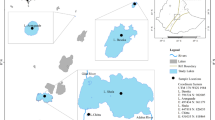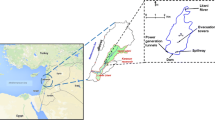Abstract
The interannual and long-term variability of abiotic characteristics and chlorophyll content is studied in reservoirs of the Middle Volga River by field observations in the summer period of 2015–2020. Water transparency increases from 1.2 ± 0.1 m in the Gorky Reservoir to 1.5 ± 0.1 m in the Kuibyshev Reservoir and electrical conductivity from 206 ± 2 to 315 ± 7 µS/cm, respectively. Water color decreases from 53 ± 1 to 38 ± 1; all these features reflect the pronounced zoning of the Volga River cascade. The water temperature depends on local weather conditions. The concentration of Ptot increases from 68 ± 3 μg/L in the Gorky Reservoir up to 145 ± 7 μg/L in the Kuibyshev Reservoir; the concentration of Ntot (1.08 ± 0.05–1.14 ± 0.06 mg/L) changes insignificantly. The content of Chl a averages 10.9 ± 0.7, 26.7 ± 3.9, and 9.2 ± 1.0 μg/L in the Gorky, Cheboksary, and Kuibyshev reservoirs, respectively; this parameter ranges widely and is characterized by interannual variability. The trophic status of the Gorky and Kuibyshev reservoirs in different years varies from mesotrophic to moderately eutrophic and eutrophic; the Cheboksary Reservoir is characterized as eutrophic throughout the entire 6-year period. The low correlation coefficients between the content of Chl a and abiotic characteristics indicates the complex and multicomponent influence of external conditions on the phytoplankton development.





Similar content being viewed by others
Notes
http://www.rushydro.ru/hydrology/informer/?date
REFERENCES
Adrian, R., O’Reilly, C.M., Zagareze, H., et al., Lakes as sentinels of climate change, Limnol., Oceanogr., 2009, vol. 54, no. 6, p. 2283.
Avakyan, A.B., Saltankini, V.P., and Sharapov, V.A., Vodokhranilishcha (Reservoirs), Moscow: Mysl’, 1987.
Babanazarova, O.V. and Lyashenko, O.A., Inferring long-term changes in the physical-chemical environment of the shallow, enriched Lake Nero from statistical and functional analyses of its phytoplankton, J. Plankton Res., 2007, vol. 29, no. 9, pp. 747. https://doi.org/10.1093/plankt/fbm055
Bertani, I., Primicerio, R., and Rossetti, G., Extreme climatic event triggers a lake regime shift that propagates across multiple trophic levels, Ecosystems, 2016, vol. 19, no. 1, p. 16. https://doi.org/10.1007/s10021-015-9914-5
Bohn, V.Y., Carmona, F., Rivas, R., et al., Development of an empirical model for chlorophyll-a and Secchi disk depth estimation for a Pampean shallow lake (Argentina), Egypt. J. Remote Sens. Space Sci., 2018, vol. 21, p. 183. https://doi.org/10.1016/j.ejrs.2017.04.005
Bulgakov, N.G. and Levich, A.P., Biogenic elements in the environment and phytoplankton: the ratio of nitrogen and phosphorus as an independent factor in regulating the structure of algocenosis, Usp. Sovrem. Biol., 1995, vol. 115, no. 1, p. 13.
Canfield, D.E., Bachmann, R.W., and Hoyer, M.V., Long-term chlorophyll trends in Florida lakes, J. Aquat. Plant Manage., 2018, vol. 56, p. 47.
Cardoso, S.J., Nabout, J.C., Farjalla, V.F., et al., Environmental factors driving phytoplankton taxonomic and functional diversity in Amazonian floodplain lakes, Hydrobiologia, 2017, vol. 802, p. 115. https://doi.org/10.1007/s10750-017-3244-x
Chen, Y., Qin, B., Teubner, K., and Dokulill, M.T., Long-term dynamics of phytoplankton assemblages: Microcystis domination in Lake Taihu, a large shallow lake in China, J. Plankton Res., 2003, vol. 25, no. 1, p. 445.
Chu, Z., Jin, X., Iwami, N., and Inamori, Y., The effect of temperature on growth characteristics and competitions of Microcystis aeruginosa and Oscillatoria mougeotii in a shallow, eutrophic lake simulator system, Hydrobiologia, 2007, vol. 581, p. 217. https://doi.org/10.1007/s10750-006-0506-4
Claesson, A., Research on recovery of polluted lakes. Algal growth potential and the availability of limiting nutrients, Acta Univ. Uppsala, 1978, no. 461, p. 1.
Ekologiya fitoplanktona Kuibyshevskogo vodokhranilishcha (Ecology of Phytoplankton of the Kuibyshev Reservoir), Leningrad: Nauka, 1989.
Gao, N., Ma, Y., Zhao, M., et al., Quantile analysis of long-term trends of near-surface chlorophyll-a in the Pearl River Plume, Water, 2020, vol. 12, p. 1662. https://doi.org/10.3390/w12061662
Gidrometeorologicheskii rezhim ozer i vodokhranilishch SSSR Kuibyshevskoe i Saratovskoe vodokhranilishcha (Hydrometeorological Regime of Lakes and Reservoirs in the USSR: Kuibyshev and Saratov Reservoirs), Leningrad: Gidrometeoizdat, 1978.
Gidrometeorologicheskii rezhim ozer i vodokhranilishch SSSR. Vodokhranilishcha Verkhnei Volgi (Hydrometeorological Regime of Lakes and Reservoirs in the USSR: Upper Volga Reservoirs), Leningrad: Gidrometeoizdat, 1975.
Jeppesen, E., Sondergaard, M., Jensen, J.P., et al., Lake responses to reduced nutrient loading – an analysis of contemporary long-term data from 35 case studies, Freshwater Biol., 2005, vol. 50, no. 9, p. 1747. https://doi.org/10.1111/j.1365-2427.2005.01415.x
Kangur, K., Milius, A., Mols, T., et al., Lake Peipsi: Changes in nutrient elements and plankton communities in the last decade, Aquat. Ecosyst. Health Manage., 2002, vol. 5, no. 3, p. 363. https://doi.org/10.1080/14634980290001913
Kitaev, S.P., Osnovy limnologii dlya gidrobiologov i ikhtiologov (Fundamentals of Limnology for Hydrobiologists and Ichthyologists), Petrozavodsk: Karel. Nauchn. Tsentr Ross. Akad. Nauk, 2007.
Kopylov, A.I., Lazareva, V.I., Mineeva, N.M. et al. Planktonic Community of a Large Eutrophic Reservoir during a Period of Anomalously High Water Temperature. Inland Water Biol., 2020, 13, 339–348. https://doi.org/10.1134/S1995082920030086
Korneva, L.G., Fitoplankton vodokhranilishch basseina Volgi (Phytoplankton of Reervoirs in the Volga River Basin), Kostroma: Kostrom. Pechatnyi Dom, 2015.
Kuibyshevskoe vodokhranilishche (nauchno-informatsionnyi spravochnik) (Kuibyshev Reservoir (A Research and Information Guide)), Tol’yatti: Inst. Ekol. Volzh. Basseina Ross. Akad. Nauk, 2008.
Lamont, T., Barlow, R.G., and Brewin, R.J.W., Long-term trends in phytoplankton chlorophyll-a and size structure in the Benguela upwelling system, JGR Oceans, 2019, vol. 124, no. 2, p. 1170. https://doi.org/10.1029/2018JC014334
Litvinov, A.S. and Zakonnova, A.V., Hydrological conditions in the Cheboksarskoe Reservoir during several years after its filling, Water Resour., 1994, vol. 21, no. 3, pp. 337–345.
Mineeva, N.M., Rastitel’nye pigmenty v vode volzhskikh vodokhranilishch (Plant Pigments in Water of the Volga Reservoirs), Moscow: Nauka, 2004.
Mineeva, N.M., Pervichnaya produktsiya planktona v vodokhranilishchakh Volgi (Plankton primary production in the reservoirs of the Volga River), Yaroslavl: Printkhaus, 2009.
Mineeva, N.M., Seasonal and interannual chlorophyll dynamics in plankton of the Rybinsk Reservoir according to fluorescent diagnostics data, in Sistematika, morfologiya i ekologiya vodnykh rastenii (Taxonomy, Morphology, and Ecology of Aquatic Plants), Yaroslavl: Filigran’, 2016, pp. 75–93.
Mineeva, N.M., Stepanova, I.E., and Semadeni, I.V., Biogenic elements and their significance in the development of phytoplankton in reservoirs of the Upper Volga, Inland Water Biol., 2021, vol. 14, no. 1, pp. 32–42. https://doi.org/10.1134/S1995082921010089
Mineeva, N.M., Litvinov, A.S., Stepanova, I.E., and Kochetkova M.Yu., Chlorophyll content and factors affecting its spatial distribution in the Middle Volga reservoirs, Inland Water Biol., 2008, vol. 1, no. 1, pp. 64–72. https://doi.org/10.1007/s12212-008-1010-5
Okhapkin, A.G., Fitoplankton Volgi. Fitoplankton Cheboksarskogo vodokhranilishcha (Volga Phytoplankton. Phytoplankton of the Cheboksary Reservoir), Tolyatti: Inst. Ekol. Volzh. Basseina Ross. Akad. Nauk, 1994.
Okhapkin, A.G., Mikul’chik, I.A., Korneva, L.G., and Mineeva, N.M., Fitoplankton Volgi. Fitoplankton Gor’kovskogo vodokhranilishcha (Volga Phytoplankton. Phytoplankton of the Gor’kiy Reservoir), Tol’yatti: Inst. Ekol. Volzh. Basseina Ross. Akad. Nauk, 1997.
Okhapkin, A.G., Sharagina, E.M., and Bondarev, O.O., Phytoplankton of the Cheboksary reservoir at the present stage of its existence, Povolzh. Ekol. Zh., 2013, no. 2, p. 190.
Özkan, K., Jeppesen, E., Davidson, T.A., et al., Long-term trends and temporal synchrony in plankton richness, diversity and biomass driven by re-oligotrophication and climate across 17 Danish Lakes, Water, 2016, vol. 8, no. 10, p. 427. https://doi.org/10.3390/w8100427
Pace, M.L. and Cole, J.J., Synchronous variation of dissolved organic carbon and color in lakes, Limnol., Oceanogr., 2002, vol. 47, no. 2, p. 333.
Pautova, V.N. and Nomokonova, V.I., Produktivnost’ fitoplanktona Kuibyshevskogo vodokhranilishcha (Phytoplankton Production of the Kuibyshev Reservoir), Tolyatti: Inst. Ekol. Volzh. Basseina Ross. Akad. Nauk, 1994.
Reynolds, C.S., Environmental requirements and habitat preferences of phytoplankton: chance and certainty in species selection, Bot. Mar., 2012, vol. 55, no. 1, p. 1. https://doi.org/10.1515/bot.2011.121
Reynolds, C.S., The Ecology of Phytoplankton, Cambridge: Cambridge Univ., 2006.
Rivers of Europe, Amsterdam: Elsevier, 2021.
Romanenko, V.I., Mikrobiologicheskie protsessy produktsii i destruktsii organicheskogo veshchestva vo vnutrennikh vodoemakh (Microbial Processes of Production and Destruction of Organic Matter in Inland Waters), Leningrad: Nauka, 1985.
Ruggiu, D., Morabito, G., Panzani, P., and Pugnetti, A., Trends and relations among basic phytoplankton characteristics in the course of the long-term oligotrophication of Lake Maggiore (Italy), Hydrobiologia, 1998, vols. 369–370, p. 243.
Sakamoto, M., Primary production by phytoplankton community in some Japanese lakes and its dependence on lake depth, Arch. Hydrobiol., 1966, vol. 62, no. 1, p. 1. https://doi.org/10.1371/journal.pone.0095757
SCOR-UNESCO Working Group № 17. Determination of photosynthetic pigments in sea water, in Monographs on Oceanographic Methodology, Montreux: UNESCO, 1966.
Seip, K.L., Jeppesen, E., Jensen, J.P., and Faafeng, B., Is trophic state or regional location the strongest determinant for Chl-a/TP relationships in lakes?, Aquat. Sci., 2000, vol. 62, p. 195. https://doi.org/10.1007/PL00001331
Struktura i funktsionirovaniem ekosistemy Rybinskogo vodokhranilishcha v nachale XXI veka (The Structure and Functioning of the Ecosystem of the Rybinsk Reservoir at the Beginning of the 21st Century), Moscow: Ross. Akad. Nauk, 2018.
Torremorell, A.M., Dieguez, C., Queimalinos, C., et al., Phytoplankton limitation in Patagonian and Pampean shallow lakes: effect of phosphorus and light, Hydrobiologia, 2018, vol. 816, p. 91. https://doi.org/10.1007/s10750-017-3181-8
Volga i ee zhizn’ (The Volga River and its life), Leningrad: Nauka, 1978.
Vtoroi otsenochnyi doklad Rosgidrometa ob izmeneniyakh klimata i ikh posledstviyakh na territorii Rossiiskoi Federatsii. Obshchee rezyume (The Second Assessment Report of Roshydromet on Climate Change and its Consequences on the Territory of the Russian Federation. General Summary), Moscow: Rosgidromet, 2014.
Winder, M. and Hunter, D.A., Temporal organization of phytoplankton communities linked to physical forcing, Oecologia, 2008, vol. 156, p. 179. https://doi.org/10.1007/s00442-008-0964-7
Yang, Y., Pettersson, K., and Padisák, J., Repetitive baselines of phytoplankton succession in an unstably stratified temperate lake (Lake Erken, Sweden): a long-term analysis, Hydrobiologia, 2016, vol. 764, no. 1, p. 211. https://doi.org/10.1007/s10750-015-2314-1
Zhukova, T.V., Long-term dynamics of phosphorus in the Narochanskie Lakes and factors determining it, Water Resour., 2013, vol. 40, no. 5, pp. 510–517. https://doi.org/10.1134/S0097807813050072
Funding
This work was carried out as part of State Task nos. 121051100099-5 and 121051100104-6.
Author information
Authors and Affiliations
Corresponding author
Ethics declarations
Conflict of interests. The authors declare that they have no conflicts of interest.
Statement on the welfare of animals. This article does not contain any studies involving animals or human participants performed by any of the authors.
Additional information
Translated by D. Martynova
Abbreviations: BE, biogenic elements; Chl a, chlorophyll a; F, Fisher’s test; n, number of observations; Ntot, total nitrogen; N-N\({\text{O}}_{3}^{ - }\), nitrate nitrogen; p, significance level; Ptot, total phosphorus; P-P\({\text{O}}_{4}^{{3 - }}\), phosphate phosphorus; r, Pearson correlation coefficient; rs, Spearman’s rank correlation coefficient; R2, coefficient of determination; Cv, coefficient of variation.
Rights and permissions
About this article
Cite this article
Mineeva, N.M., Poddubny, S.A., Stepanova, I.E. et al. Abiotic Factors and Their Role in Phytoplankton Development in Reservoirs of the Middle Volga River, Russia. Inland Water Biol 15, 729–739 (2022). https://doi.org/10.1134/S1995082922060141
Received:
Revised:
Accepted:
Published:
Issue Date:
DOI: https://doi.org/10.1134/S1995082922060141




